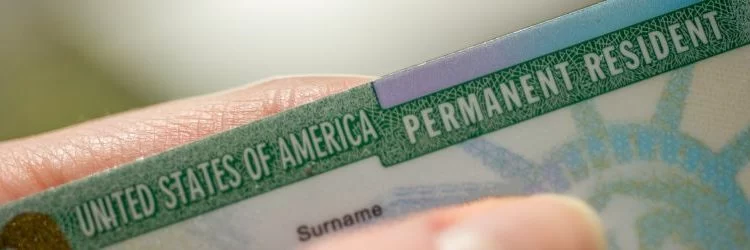How to File for a Green Card: A Step-by-Step Guide to Becoming a U.S. Permanent Resident
- 1. What is a Green Card and Why Should You Apply?
- 2. Understanding the Green Card Application Process
- 3. Who is Eligible for a Green Card?
- 4. Common Steps in the Green Card Filing Process
- 5. Real Stories: Successful Green Card Applications
- 6. How an Immigration Lawyer Can Help with Your Green Card Filing
- 7. Next Steps: How to Get Started with Your Green Card Application
1. What is a Green Card and Why Should You Apply?
A U.S. green card is an official document that grants permanent residency status in the United States. Holding a green card allows you to live and work in the U.S. without needing a work visa or other temporary status. It is a coveted status for individuals who wish to build a life in the U.S. Whether you’re looking for better job opportunities, education, or simply a new beginning, a green card is the first step toward permanent residency.
Many immigrants, after spending years in the U.S., consider applying for a green card to secure their future and that of their family. A green card holder can apply for U.S. citizenship after a certain period, giving them access to even more rights and privileges.
2. Understanding the Green Card Application Process
The green card application process can be complex, and it’s essential to understand the steps involved. In general, the process includes:
- Step 1: Determine Your Eligibility: Before applying, you must meet certain eligibility criteria, including family sponsorship, employment-based petitions, or refugee or asylum status.
- Step 2: File the Correct Petition: This could involve submitting a family-based petition (Form I-130) or an employment-based petition (Form I-140), depending on the basis for your green card application.
- Step 3: Adjustment of Status or Consular Processing: If you are already in the U.S., you may apply for an adjustment of status to become a permanent resident. Otherwise, you’ll go through consular processing, where you’ll apply at a U.S. embassy or consulate abroad.
- Step 4: Biometrics and Interview: Applicants typically need to attend a biometrics appointment to provide fingerprints and undergo a background check. In some cases, an in-person interview is required.
- Step 5: Wait for a Decision: Once all documents and interviews are completed, the final step is to wait for your green card approval. The processing time can vary based on the type of application.
Throughout the process, having a clear understanding of what documents to submit and how to navigate each step is critical to ensuring a smooth application experience.
3. Who is Eligible for a Green Card?
Eligibility for a green card depends on several factors. Here are some of the most common categories of eligibility:
- Family-Based Eligibility: U.S. citizens and permanent residents can sponsor certain family members, such as spouses, children, and parents, for a green card.
- Employment-Based Eligibility: Individuals with specialized skills or job offers from U.S. employers may apply for a green card through employment-based petitions.
- Refugee or Asylum Status: Those who have been granted asylum or refugee status in the U.S. can apply for a green card after one year of residing in the country.
- Diversity Visa Program: The U.S. also offers a lottery program for individuals from countries with low immigration rates to the U.S. who meet certain criteria.
- Other Special Categories: Some individuals may be eligible through other special programs such as the Cuban Adjustment Act or through specific visas like the U Visa for crime victims.
Understanding your eligibility category will help you determine which specific forms to file and what documentation to prepare for your green card application.
4. Common Steps in the Green Card Filing Process
Once you've determined that you're eligible to apply for a green card, the next step is to gather the necessary documentation and begin the process. Here’s an overview of the typical steps:
- File the Petition: Submit the appropriate petition forms to the U.S. Citizenship and Immigration Services (USCIS), either through family or employment-based channels.
- Submit Supporting Documents: This can include birth certificates, proof of relationships (such as marriage certificates), proof of employment, or evidence of your legal entry into the U.S.
- Biometrics and Medical Exams: You’ll likely be asked to undergo fingerprinting, and in some cases, a medical exam, to confirm you meet the health requirements for admission.
- Wait for Approval: After submitting your petition and attending required interviews, you’ll have to wait for the USCIS to approve your application. Processing times can vary.
Completing each of these steps carefully will help ensure that your green card application is processed as efficiently as possible.
5. Real Stories: Successful Green Card Applications
Hearing about others’ experiences can provide invaluable insight into the green card application process. Take Maria and Carlos, for example. They both immigrated to the U.S. as young professionals and decided to apply for a green card through their employer. After carefully following the steps, including gathering their documents and attending an interview, they received their green cards within a year. Maria says, “The process seemed overwhelming at first, but with the right guidance, we made it through, and now we’re living our American dream!”
Stories like Maria and Carlos’s demonstrate that, while the green card application process can be long and complex, it’s absolutely achievable with careful preparation and a clear understanding of the steps involved.
6. How an Immigration Lawyer Can Help with Your Green Card Filing
Applying for a green card is often a complex process that can involve significant paperwork, interviews, and long wait times. Working with an experienced immigration lawyer can help streamline your application and minimize the risk of errors or delays. Immigration lawyers specialize in understanding the nuances of U.S. immigration law and can guide you through every step of the process—from determining eligibility to submitting the right documents and preparing for interviews.
Hiring an immigration lawyer can be especially important if your case involves complications such as past immigration violations, criminal history, or unusual circumstances. They will be able to provide tailored advice and represent your interests to ensure the best possible outcome.
If you’re ready to get started on your green card application, consider contacting an expert immigration lawyer to help you navigate the process successfully.
7. Next Steps: How to Get Started with Your Green Card Application
Ready to apply for a green card? The first step is to evaluate your eligibility. Once you know which category you fall under, you can start gathering the necessary documentation and file the appropriate petition. For a smoother and more efficient process, consider working with an immigration lawyer who specializes in green card applications.
Start your green card journey today by visiting Free Range Lawyers, where you can schedule a consultation with an experienced immigration attorney who will guide you through every step of the process.






